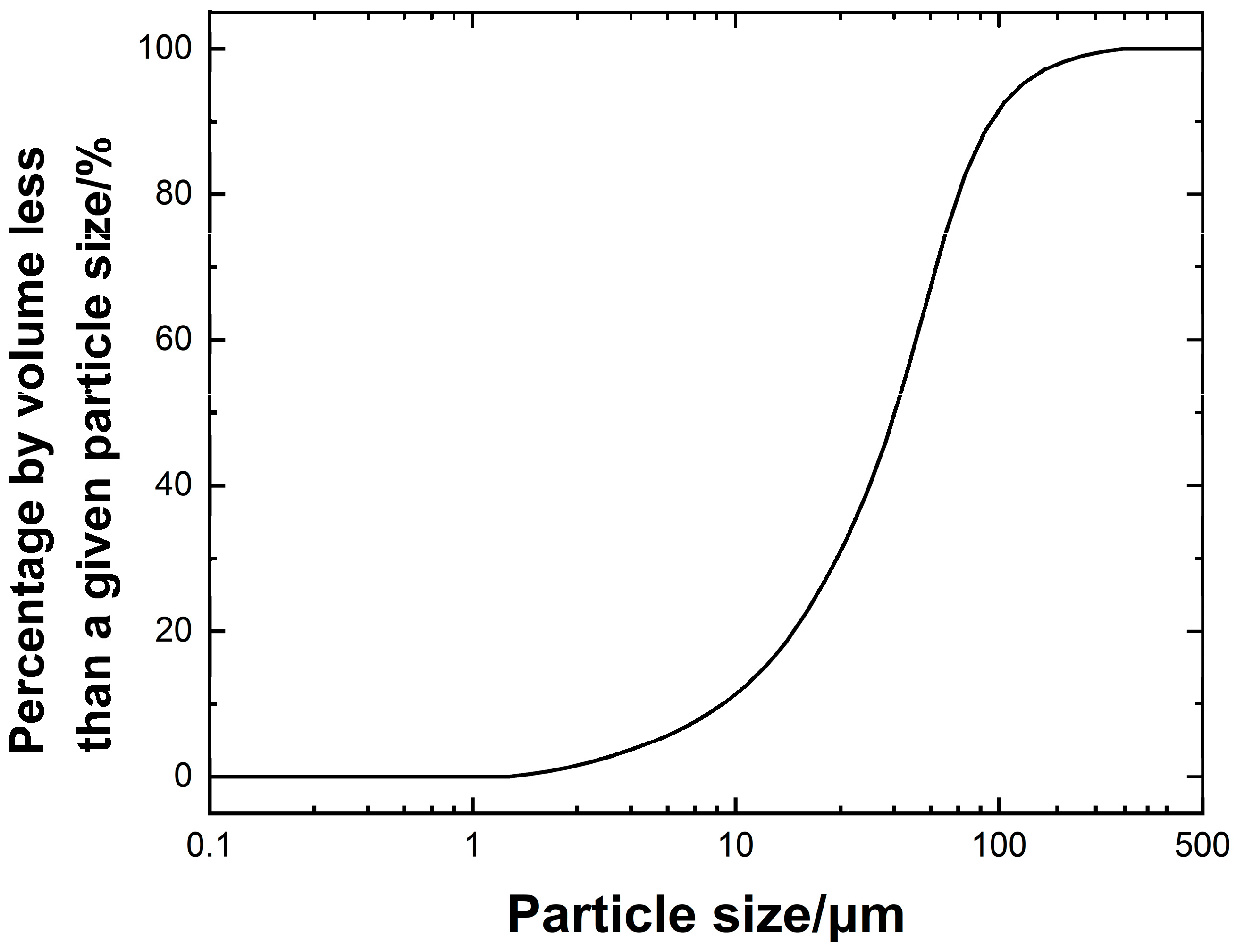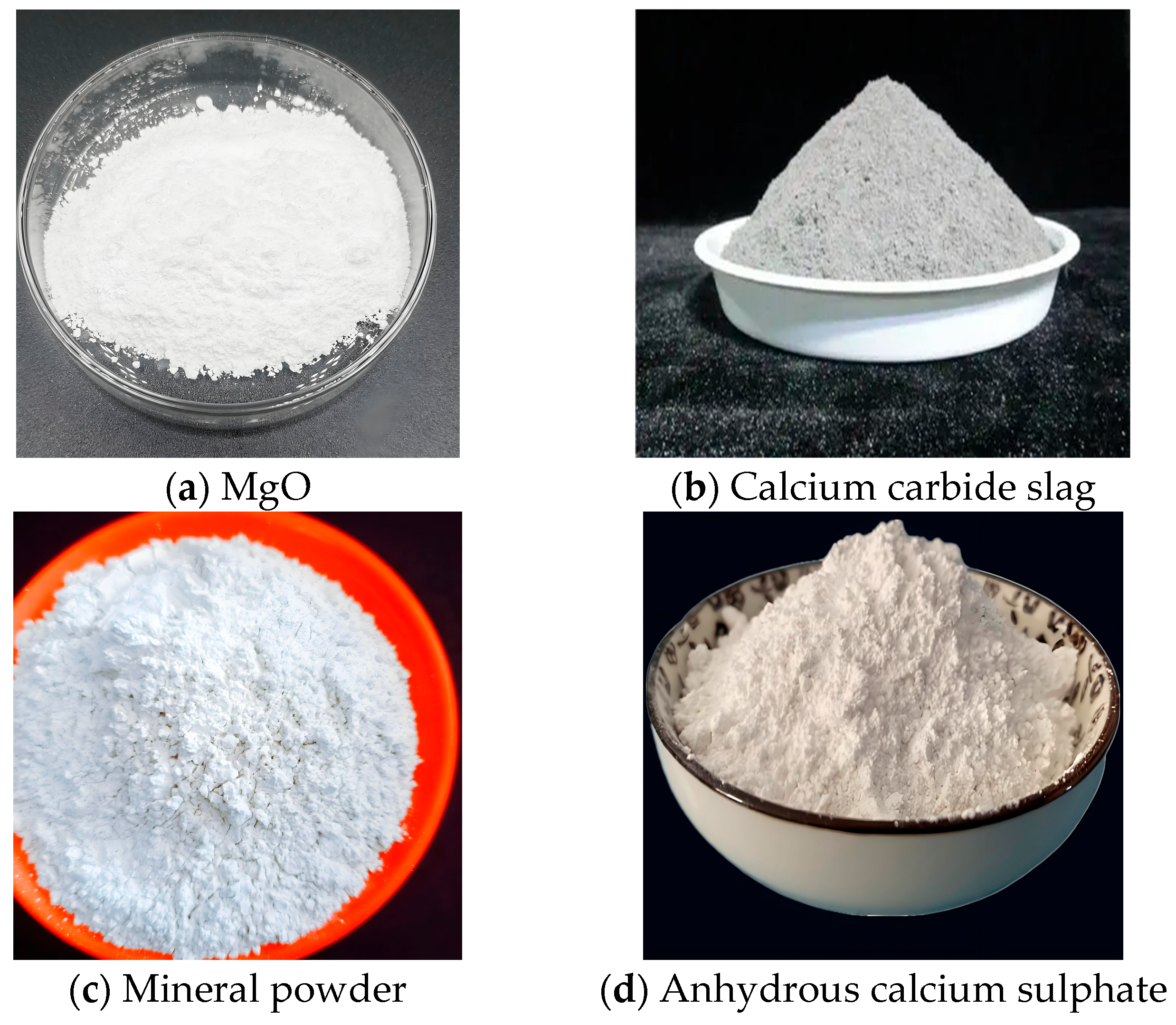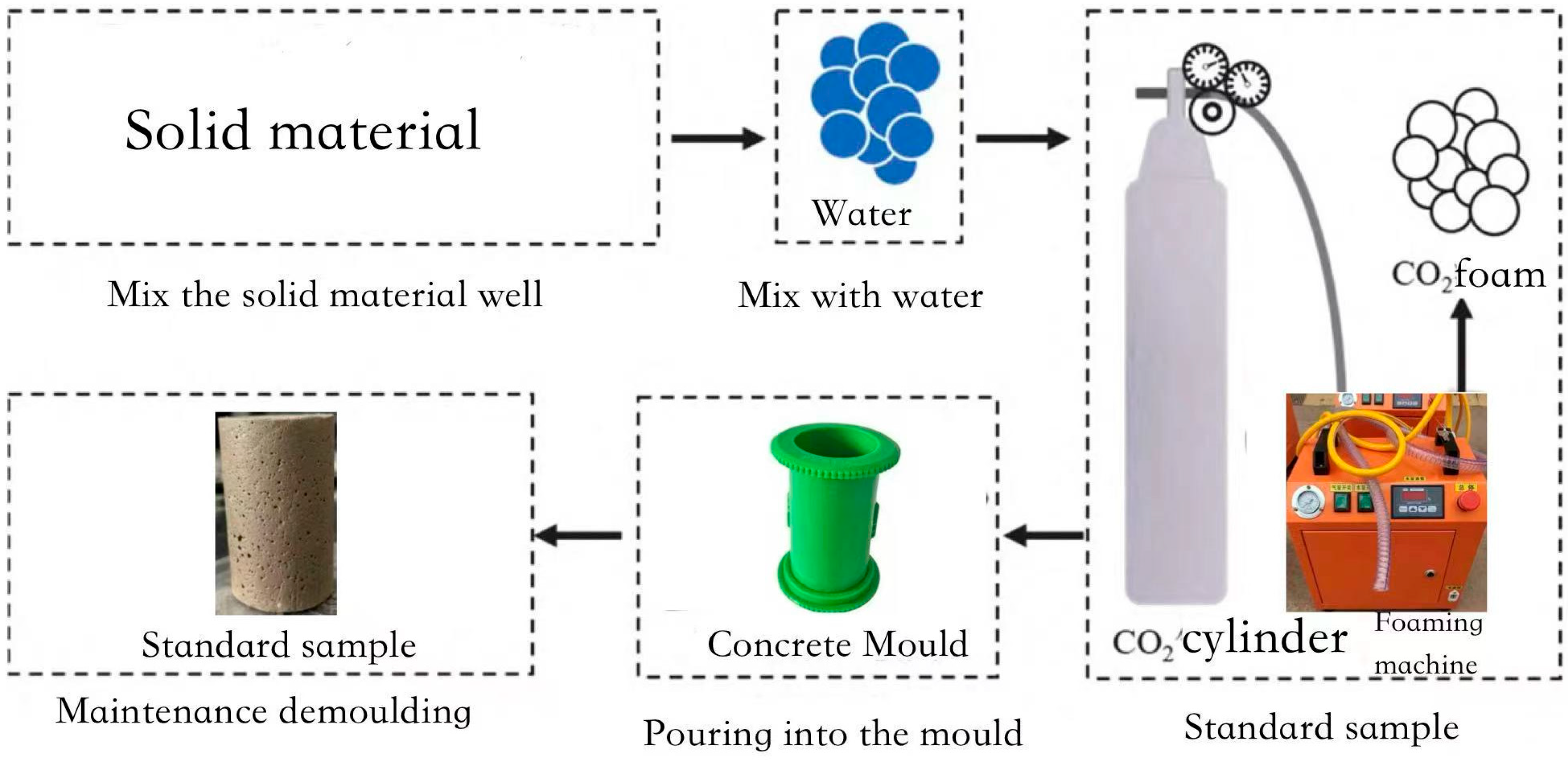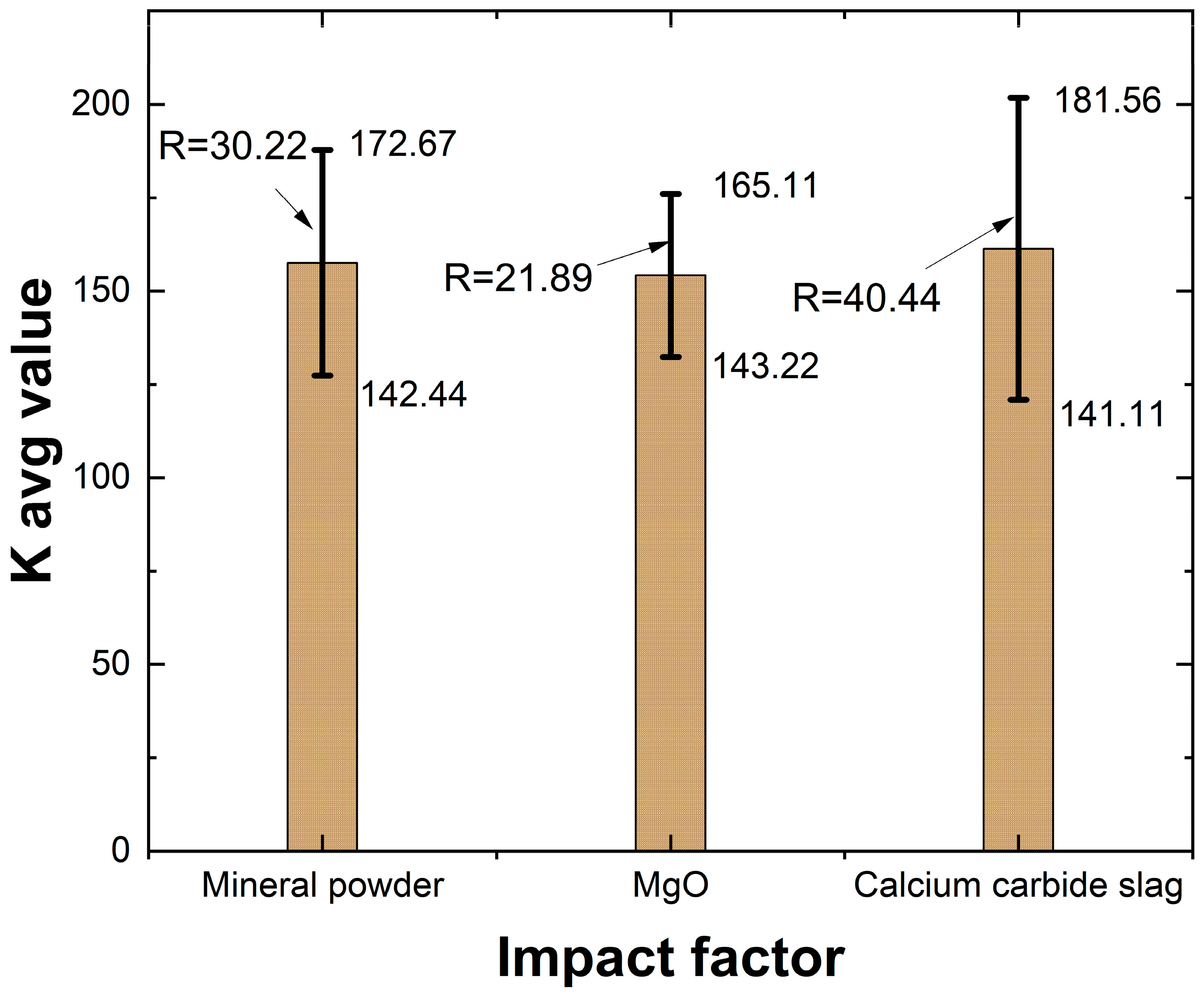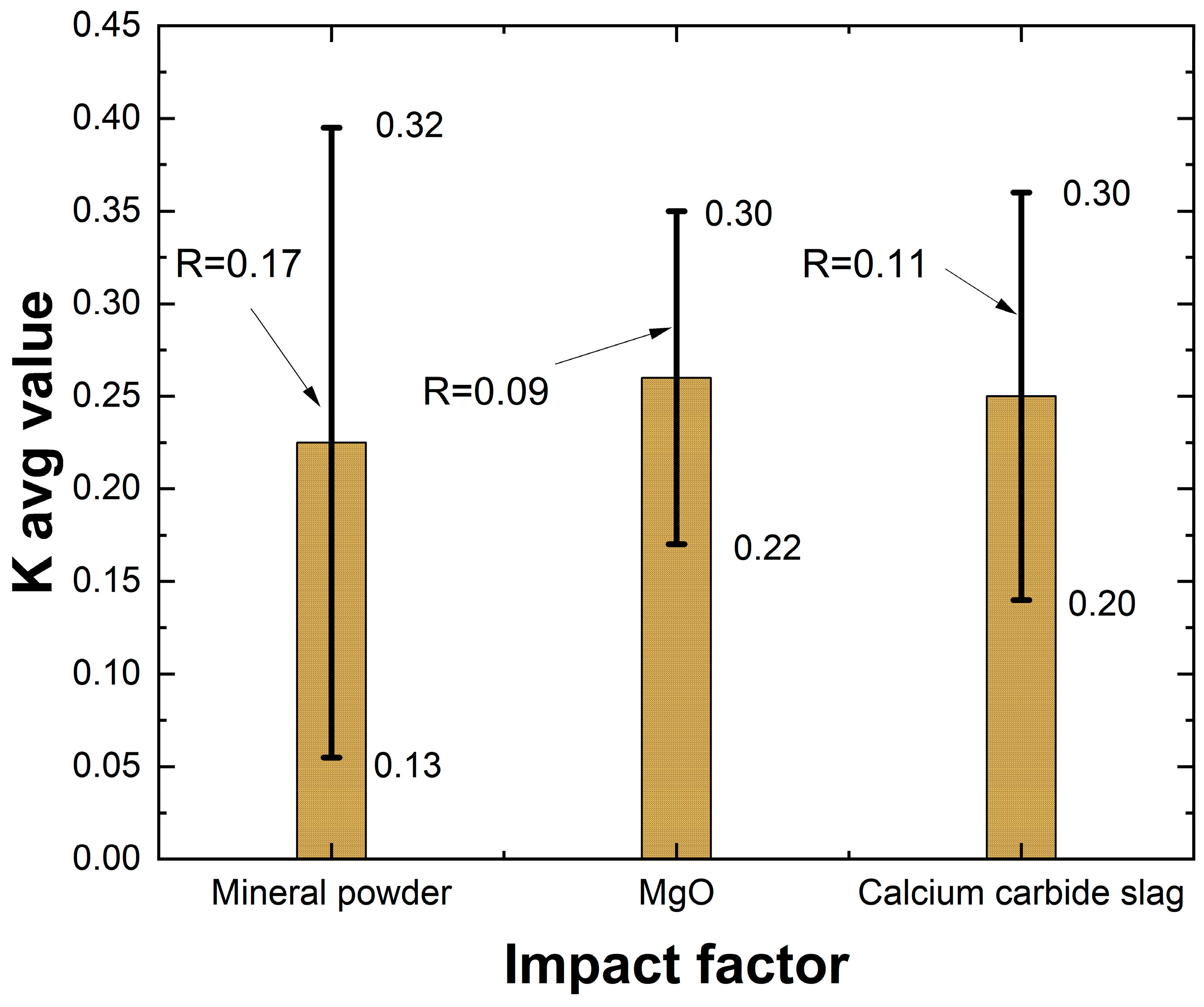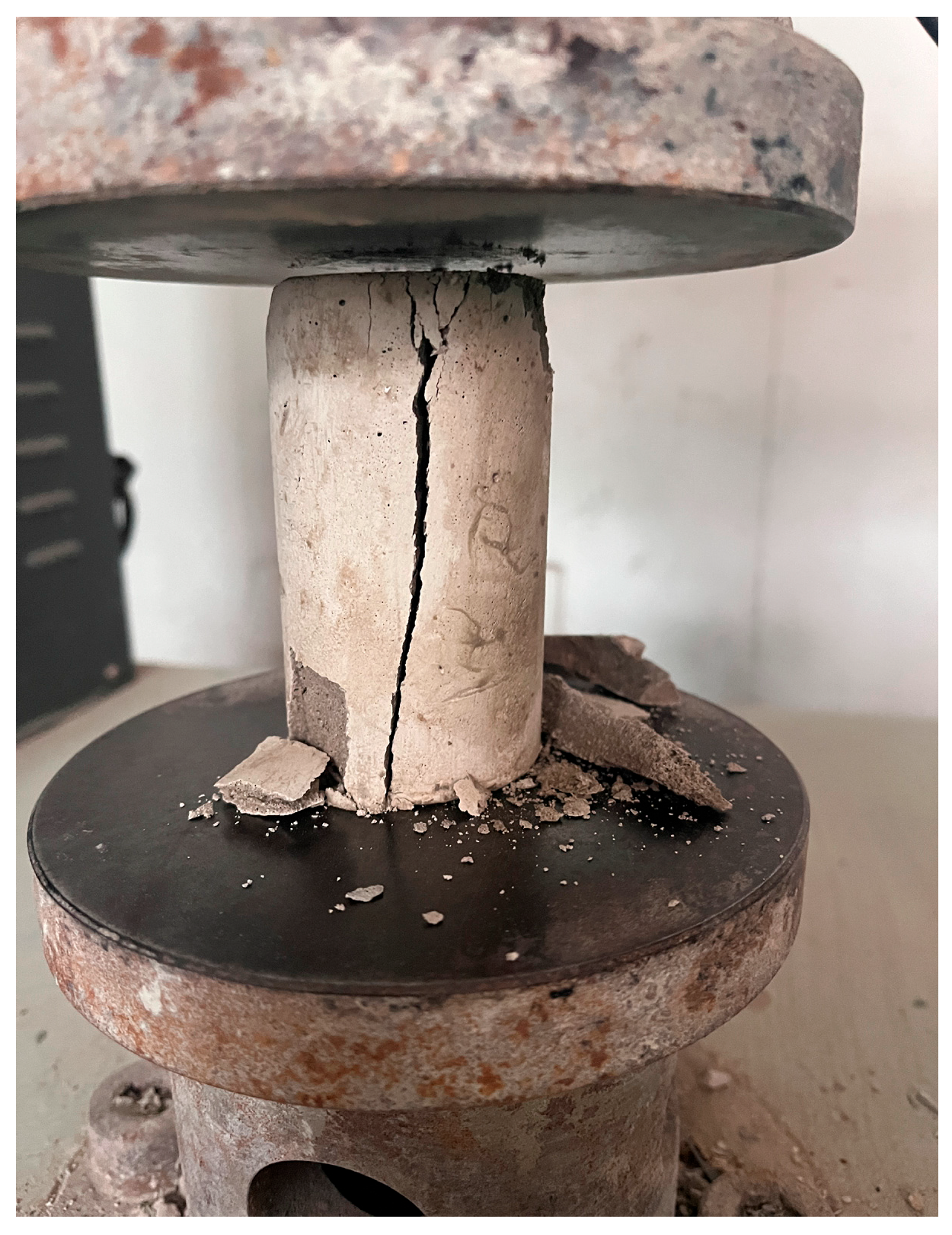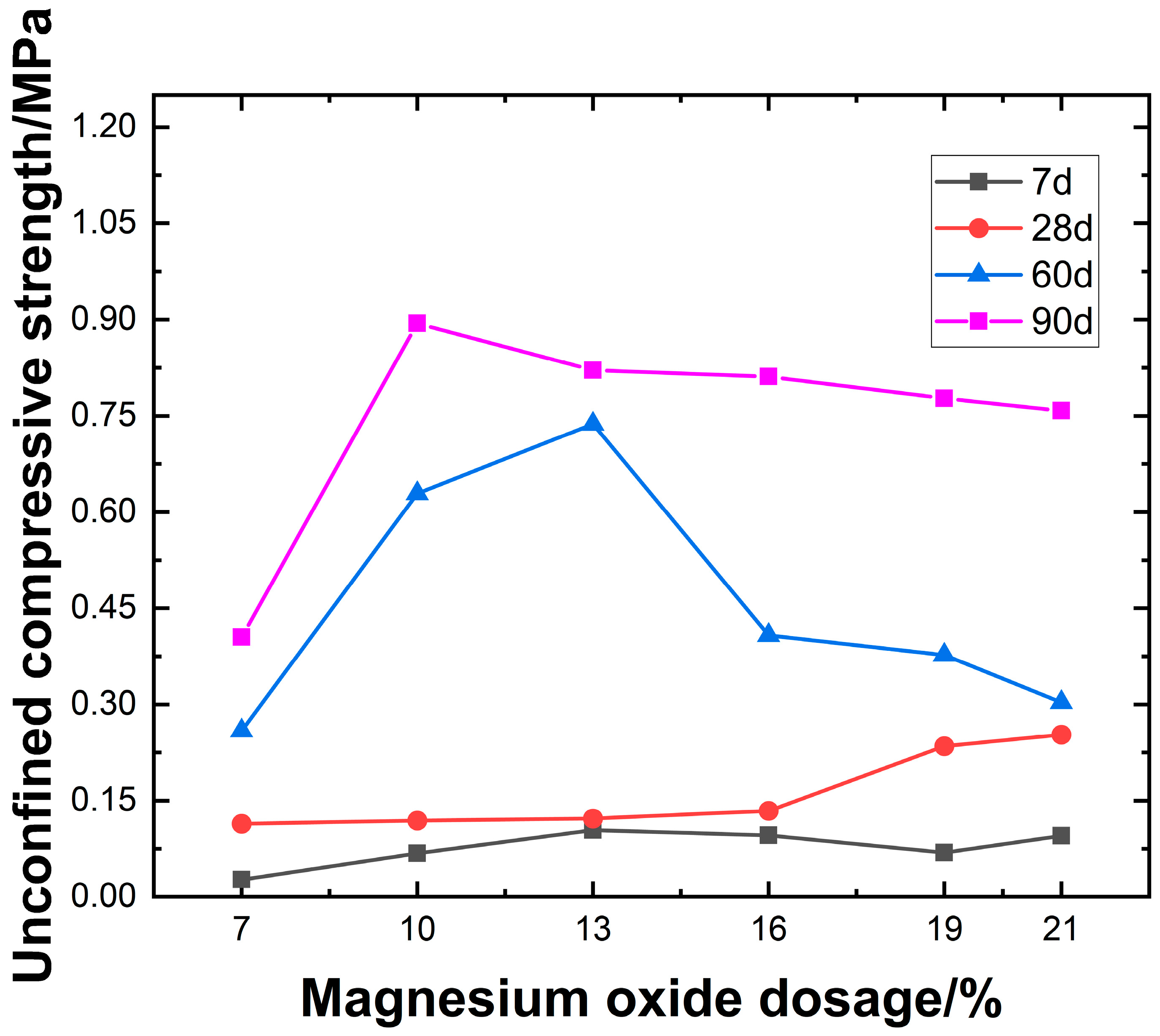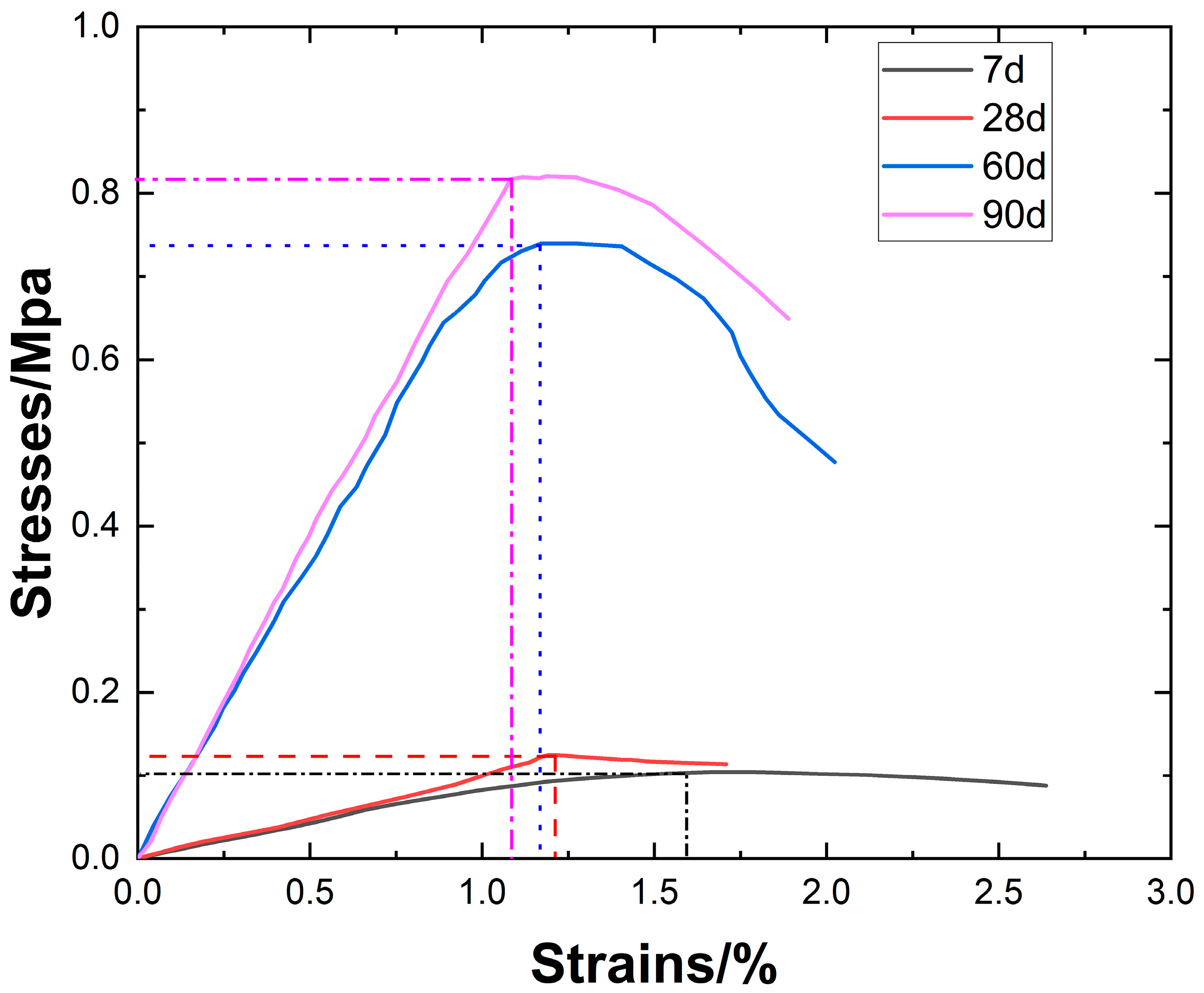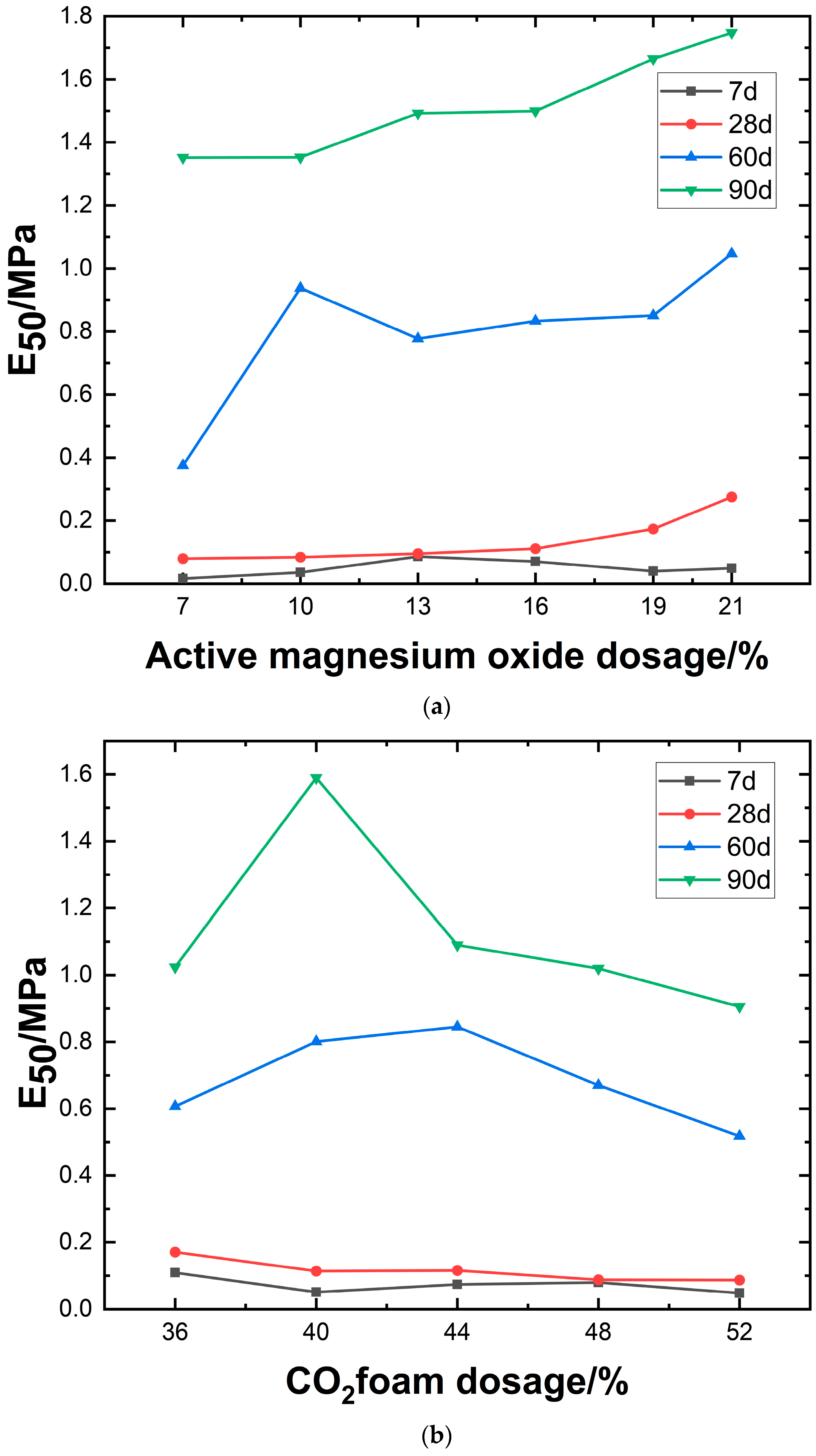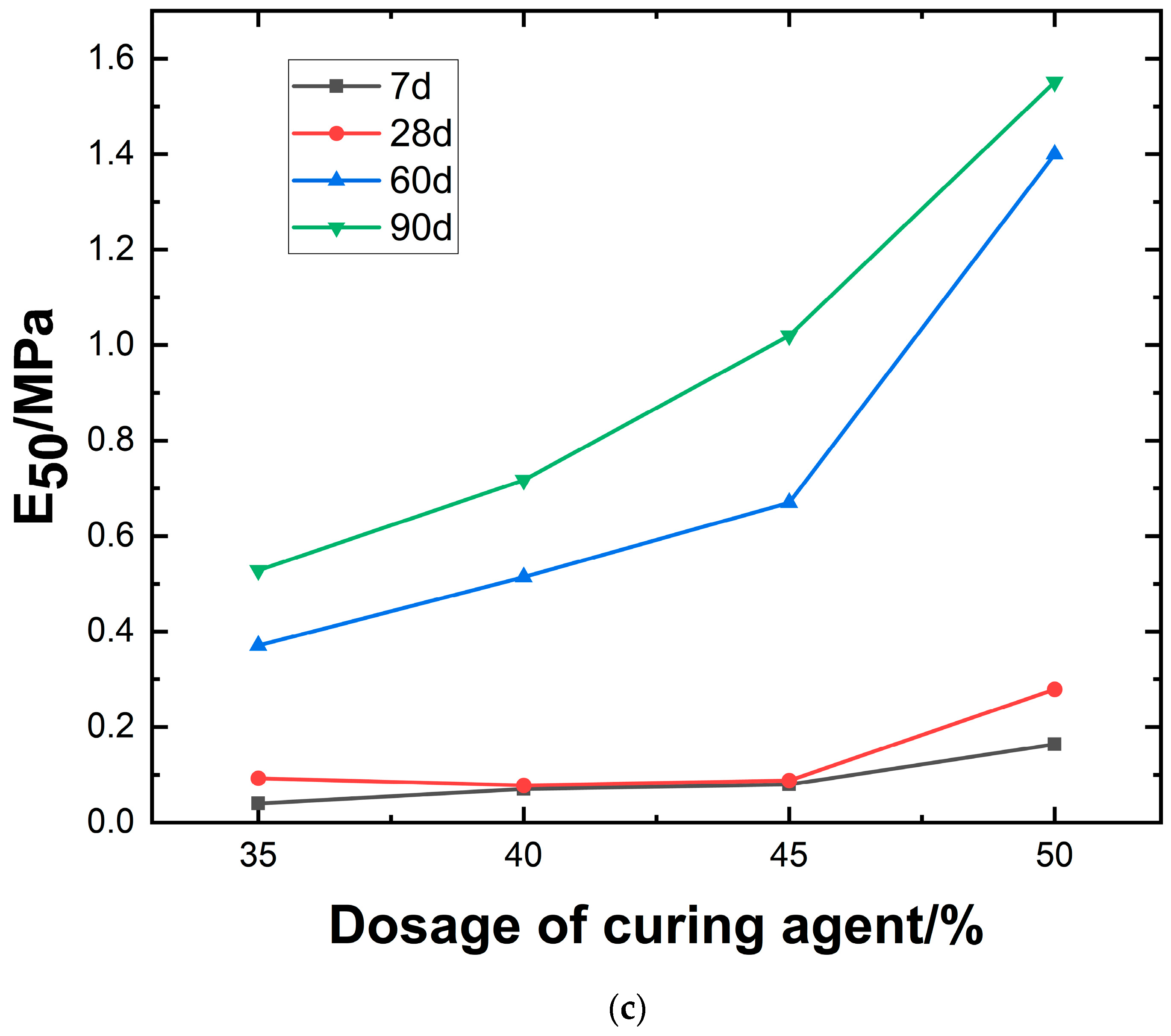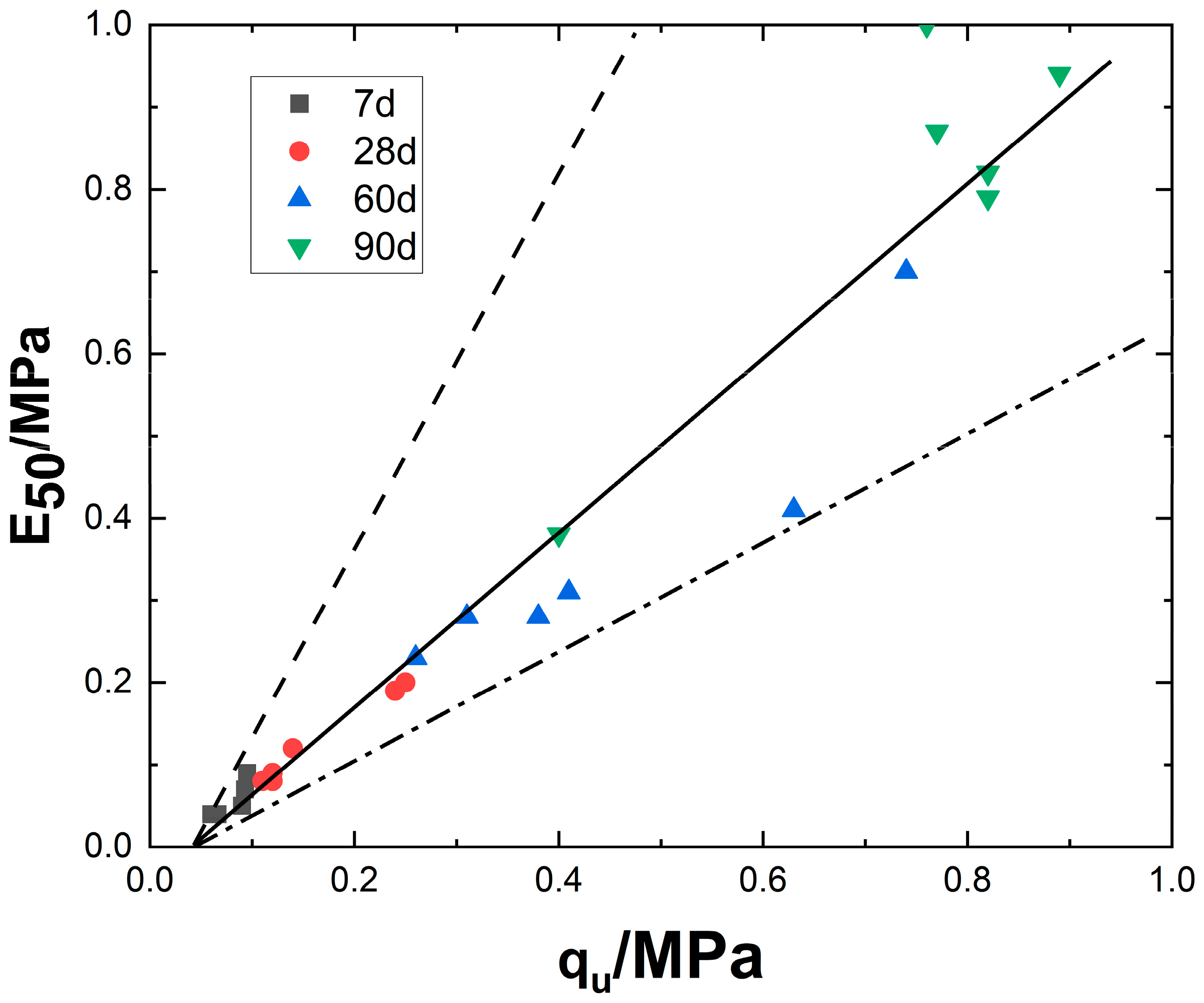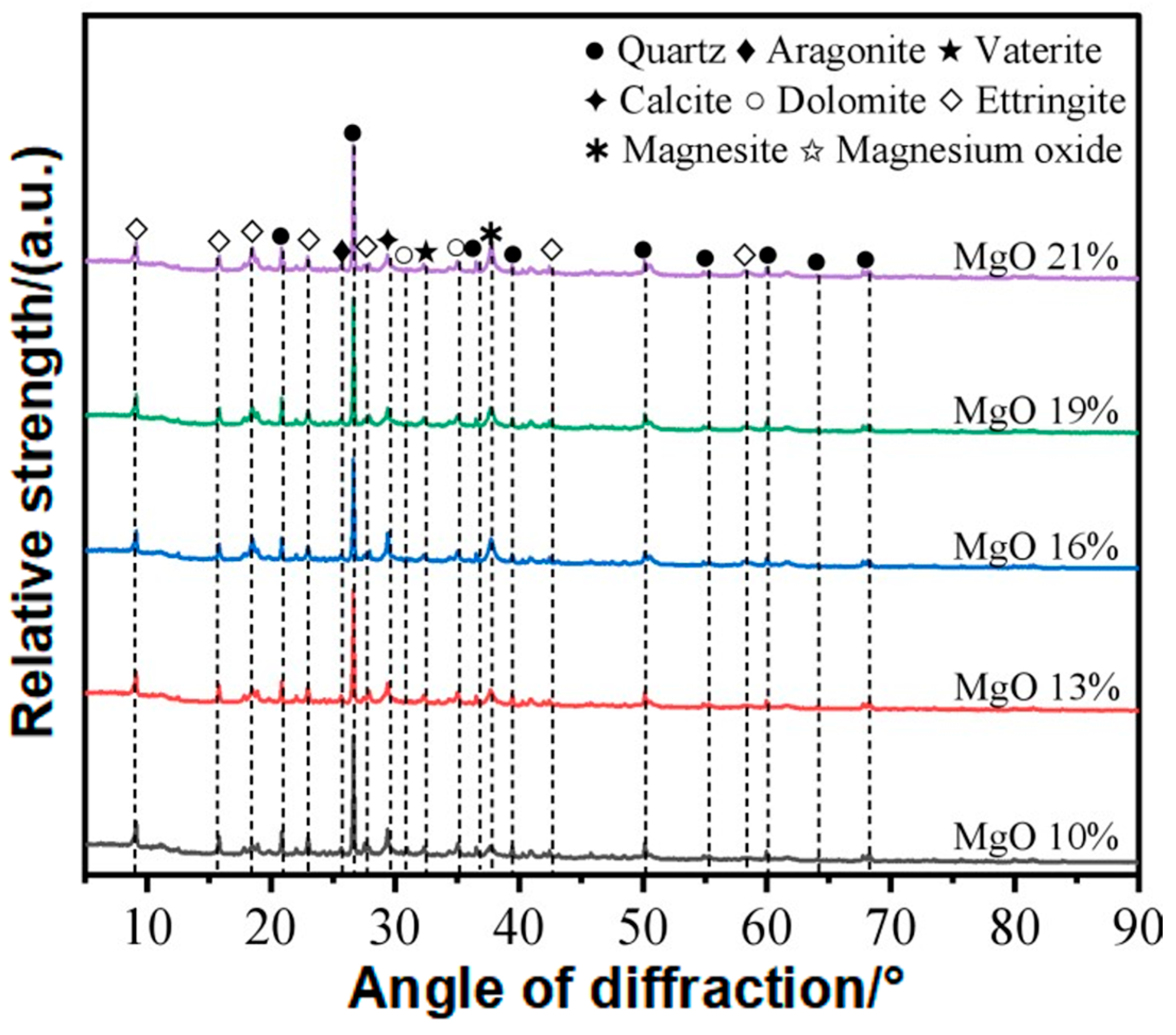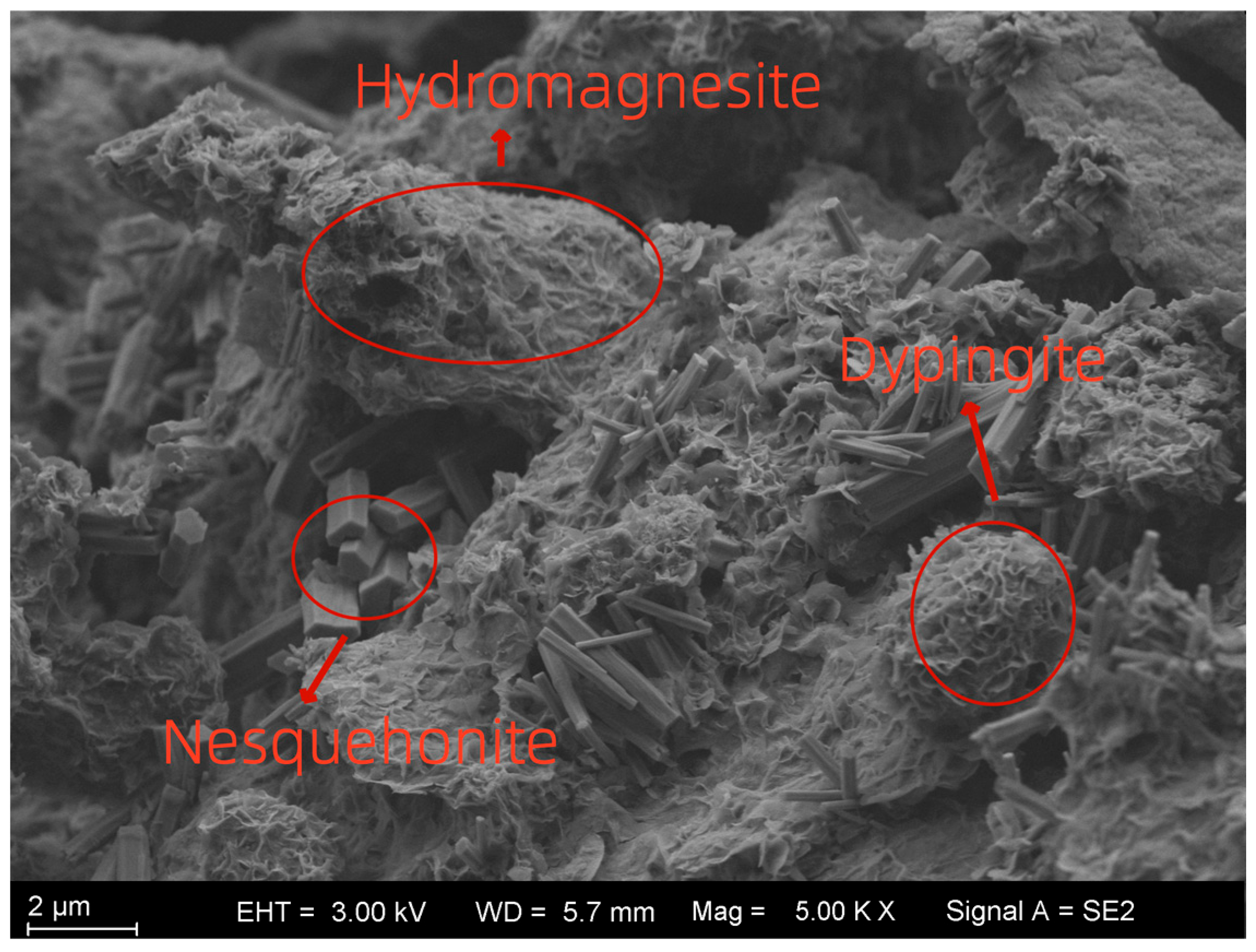1. Introduction
With urbanization and the growing emphasis on environmental protection, global warming caused by the greenhouse effect has gained increasing attention. Consequently, reducing and managing CO
2, the primary greenhouse gas, has become a key environmental issue. Research indicates that capturing and storing emitted CO
2 is the most direct and effective method for reducing atmospheric CO
2 concentrations. The primary approaches for controlling total CO
2 emissions include enhancing CO
2 utilization, reducing emissions at the source, geological storage, ocean storage, and mineral carbonation [
1]. In the field of civil engineering, the application of carbon sequestration technology offers new perspectives for the development of “green civil engineering.”
With the accelerated pace of urbanization, the amount of waste slurry generated from construction activities continues to increase. The 2024 Special Research and In-Depth Analysis Report on China’s Construction Waste Treatment Industry [
2] indicates that China’s annual construction waste production has reached the scale of 1 billion tons, while its resource utilization rate remains low. Without proper treatment, this waste could lead to secondary environmental issues such as water and soil contamination. Additionally, due to limited urban land and high population density, waste slurry disposal has become an urgent issue.
To address these issues, civil engineering researchers have developed carbonation-stabilized lightweight soil to facilitate waste slurry recycling. This material not only absorbs CO2 but also efficiently utilizes construction waste. Converting construction waste into new building materials reduces soil accumulation and minimizes the risk of secondary pollution during disposal. Construction waste can react with carbon capture materials to form stable carbon sequestration products, effectively managing waste while achieving carbon storage. Currently, research in this field primarily focuses on the development of waste slurry recycling technologies and magnesium oxide-based carbon sequestration techniques.
To address the issue of waste slurry recycling, He et al. [
3] conducted a study on marine clay and found that the addition of polyacrylamide (PAM) promotes the formation of large-flake flocs in waste slurry, effectively improving its performance and enabling rapid solid–liquid separation. Yadu [
4] found through unconfined compressive strength tests that granulated blast furnace slag (GGBS) significantly improves the strength of soft soil, although excessive amounts of mineral powder have limited effect on strength improvement. Singhi [
5] incorporated a mixture of slag and fly ash into soft soil for soil improvement, and the study showed that the strength of the stabilized soil increased significantly with higher amounts of composite stabilizers. However, traditional stabilizers cause significant environmental pollution, making the search for stabilizers that balance performance and environmental friendliness one of the key research focuses in this field.
Recent work from 2022 to 2024 has significantly advanced CO
2 mineralization and carbonation-based stabilization in geotechnical engineering. Wang et al. [
6] prepared low-carbon foamed lightweight soil using cement, GBFS, and fly ash, achieving 28-day unconfined compressive strength values of 1.9 MPa at 600 kg/m
3 density while reducing CO
2 emissions by up to 70% compared with pure cement systems. Investigations into accelerated carbonation of alkali-activated slag stabilized sandy soil confirmed that carbonation promotes carbonate formation and strength gains under both ambient and elevated curing conditions [
7]. Ngo et al. [
8] proposed a sol–gel stabilized CO
2 foam to enhance in situ carbonation in foamed fly ash backfills, demonstrating improved strength and microstructure. Que et al. [
9] showed that marine sand-amended FLS can achieve unconfined compressive strength values of 0.95–2.64 MPa with flowability between 160 and 229 mm, underscoring the versatility of FLS in sustainable design. Furthermore, field-scale trials with MgO-carbonated composite piles [
10] highlighted the feasibility of applying mineral carbonation to large-diameter ground improvement piles, combining improved load-bearing capacity with substantial CO
2 emission reductions. These recent studies emphasize both the potential and necessity of integrating CO
2 mineralization into geotechnical engineering, providing stronger support for the approach adopted in this study.
Magnesium oxide (MgO), known for its high reactivity, has been widely studied as a low-carbon binder [
11]. Active MgO, with its high reactivity, easily undergoes ion exchange reactions with heavy metal ions in polluted soil, and is currently applied in the stabilization of polluted soil. Zhang et al. [
12] compared the performance and mechanisms of CaO-GGBS, MgO-GGBS, and ordinary Portland cement in the treatment of zinc-contaminated clay slurry through unconfined compressive strength tests, leaching tests, and thermal analysis. The study showed that MgO-GGBS positively affects the stabilization of polluted soil, significantly improving soil strength. Srinath and Abir [
13] studied the stabilization of polluted soil with magnesium oxide cement and found that the pH of the stabilized soil decreased to 6.5–9.2. The leachate concentration of heavy metals decreased significantly, and the mechanical strength and durability were greatly enhanced. Qiang et al. [
14] found that the ion leachate concentration and pH of MgO-GGBS stabilized soil remained stable after 90 days.
More recent research has also highlighted the effectiveness of MgO carbonation curing, demonstrating enhanced strength, durability, and CO
2 uptake [
15,
16]. Furthermore, composite systems combining MgO with carbide slag or other additives have been shown to optimize strength development and broaden MgO’s application in soil stabilization [
17,
18,
19]. However, current studies still exhibit several limitations. Most research has focused on low-water-content soils, whereas the stabilization of high-water-content waste slurry remains insufficiently addressed. In addition, conventional cement-based foamed lightweight soils typically exhibit low strength and limited CO
2 sequestration, while MgO carbonation studies are often confined to controlled conditions without solving the issue of foam instability and pore collapse in slurry systems. To overcome these challenges, this study introduces an innovative solidification pathway by integrating a MgO–mineral powder–carbide slag composite binder with CO
2 foaming–carbonation. This approach enables simultaneous lightweighting, strength improvement, and CO
2 fixation, thereby filling the gap in high water-content slurry stabilization. Furthermore, it systematically reveals, for the first time, the effects of binder ratios on mechanical behavior, microstructural characteristics, and carbon–magnesium reaction mechanisms, offering both engineering feasibility and environmental benefits.
2. Test Materials and Programs
2.1. Test Materials
- (1)
Waste slurry
The experimental waste slurry was sourced from a bored pile construction project at the West Bund Camp in Xuhui District, Shanghai. It was characterized by a dark grayish-black appearance and high water content. To avoid moisture loss, sampling, transportation, and storage were carried out in sealed containers. Basic physical indices, including water content, pH, liquid limit, plastic limit, and specific gravity, were tested in accordance with the
Standard for Geotechnical Testing Methods (GB/T 50123-2019) [
20] and the
Testing Code for Wall-Stabilizing Slurry in Hydropower Engineering (DL/T 5815-2020) [
21]. The results are summarized in
Table 1. The soil particle size distribution was determined using a laser particle size analyzer, as illustrated in
Figure 1. The curve indicates that most particles are distributed in the 10–100 μm range, with a narrow spread, reflecting poor gradation.
- (2)
MgO
In this experiment, STARMAG150 active MgO was used. It appears as a pure white, ultrafine powder (
Figure 2a), with a density of 0.48 g/cm
3 and a MgO content of up to 98%. Its chemical composition and content are listed in
Table 2. STARMAG150 exhibits excellent reactivity and high density.
- (3)
Calcium carbide slag
This experiment used high-quality, first-grade carbide slag powder, which is fine-textured and gray in appearance (
Figure 2b). It exhibits high reactivity, with a particle size ranging from 150 to 400 mesh and a density of 1.5 g/cm
3. The specific chemical composition is listed in
Table 3.
- (4)
Mineral powder
This experiment used S95-grade slag powder with a density of 2.8 g/cm
3, a flow ratio of 98%, a loss on ignition (LOI) of 0.84%, and a moisture content of 0.45%. It appears grayish-white (
Figure 2c). The specific chemical composition is listed in
Table 4.
- (5)
Anhydrous calcium sulphate, PAM and CO2
The anhydrous calcium sulfate used in this experiment is of analytical reagent (AR) grade (
Figure 2d). The specific technical specifications are listed in
Table 5.
The anionic polyacrylamide (PAM), also known as analytical-grade PAM, has a PAM content of no less than 90% and a hydrolysis degree of 30%. It appears as a white crystalline substance, with a pH range of 5.0–7.0 and an anionic value of 1.2–1.6. It exhibits excellent flocculation performance.
The CO2 gas used is high-purity, food-grade CO2 with a purity of up to 99%.
- (6)
Foaming agents
Since lightweight carbonated solidified slurry is alkaline, using an acidic foaming agent would cause CO2 foam to dissolve easily within the slurry, leading to severe defoaming and collapse, which hinders strength development. Therefore, the foaming agent used in this study was an alkaline-type foaming agent mainly composed of anionic surfactants (e.g., sodium dodecylbenzene sulfonate), alkaline additives (sodium hydroxide), and a small amount of stabilizers (lignosulfonate and cellulose ether). The alkaline environment reduces the surface tension of the solution, promoting foam generation, while the stabilizers enhance the foam’s stability and resistance to collapse. Although it readily reacts with CO2, its effects can be mitigated through pre-treatment. The CO2 foam generated with an alkaline foaming agent remains largely insoluble in the slurry, preventing significant collapse and minimizing its impact on strength. Additionally, the foam expansion ratio is high, and foam stability is well-maintained. When air is used for foaming, the resulting foam density is 40 kg/m3, whereas CO2 foaming results in a foam density of 80 kg/m3. The binder system was designed as a combination of reactive MgO, Calcium carbide slag, and Mineral powder to exploit their synergistic effects. Reactive MgO hydrates and carbonates, contributing both strength and CO2 sequestration. Calcium carbide slag rapidly hydrates to provide alkalinity and Ca2+, promoting the dissolution of mineral powder and precipitation of CaCO3. Mineral powder, as a latent hydraulic material, reacts with Ca2+ and OH− to form C–S–H gel, further densifying the matrix. This composite design overcomes the limitations of single binders—such as the slow carbonation of MgO, the expansive behavior of calcium carbide slag, and the low reactivity of mineral powder—and achieves a balance of strength, stability, and carbon fixation, making it particularly suitable for high water-content waste slurry.
2.2. Specimen Preparation
The preparation flowchart is shown in
Figure 3 with the following steps:
(1) Preparation of Mixed Slurry: The slurry collected from the construction site undergoes stirring and drying as pre-treatment before being stored in a sealed container for later use. Prior to testing, high-water-content slurry is prepared at a preset water content of 200%. The solidifying agent is then weighed according to the mix design calculations. First, the powdered solidifying agent is mixed evenly and then gradually added in two separate batches to the prepared high-water-content slurry while stirring. Each batch is stirred for 3 min to ensure thorough mixing of the solidifying agent and slurry.
(2) Preparation of CO2 Bubble Clusters: CO2 foaming requires pre-treatment of the foaming agent. Since the foaming agent is alkaline and readily reacts with CO2, and CO2 exhibits some solubility in solution, the foam tends to be unstable and dissipates quickly. Therefore, pre-treatment is necessary. The foaming agent is diluted at a 1:40 ratio before CO2 gas is introduced, with the pressure adjusted to 200 kPa. Once foaming stabilizes, the gas inlet valve is closed, and the mixture is left undisturbed for 20 min to allow full reaction between CO2 and the foaming agent. During this period, the foaming machine pressure is maintained; if pressure drops, the inlet valve is reopened to restore stability. The foaming machine is then activated, and foaming pressure is adjusted. Once stable foaming is achieved, the foam is left undisturbed for 10 min to ensure uniform and stable formation.
(3) Preparation and Pouring of Lightweight Slurry: The foam, which has been left to rest, is measured using a graduated cylinder according to the mix ratio and added to the prepared slurry. The mixture is then stirred for 1 min to ensure thorough and uniform mixing for carbonation. The mixed slurry is poured into the mold for the experiment in three batches. Due to the self-compacting nature of foam-based lightweight slurry, gentle vibration is sufficient to achieve uniform filling. Finally, a transparent plastic film is placed over the poured mold to prevent moisture loss.
(4) Curing: The cast specimens are placed in a standard curing chamber set to a temperature of 20 °C (±1 °C) and humidity of 99% for standard curing. The curing conditions of 20 ± 1 °C and 99% relative humidity were selected in accordance with
the Standard for Geotechnical Testing Methods (GB/T 50123-2019) [
20] and
the Technical Specification for Bubble-Mixed Lightweight Soil Filling Engineering (CJJ/T177-2012) [
22], which specify these parameters as reference conditions for evaluating stabilized soils. This choice also reflects field environments where lightweight carbonated stabilized soil is typically applied, such as tunnel backfilling and foundation treatment. In such scenarios, the soil mass remains in a nearly saturated state with minimal temperature fluctuation, providing a similar hydrothermal environment to that of the laboratory curing chamber. Therefore, adopting these curing conditions not only ensured methodological consistency but also enhanced the representativeness and applicability of the experimental results to practical engineering situations. After 48 h, the specimens are demolded and covered with plastic film before being returned to the curing chamber for continued standard curing until the required age for testing is reached.
2.3. Test Methods
In this study, the dosages of mineral powder, active MgO, and carbide slag were selected as factors for a three-factor, three-level orthogonal experiment using the CO
2 foaming method. The aim was to investigate the impact of different factors on the physical and mechanical properties of high-water-content waste slurry after 28 days of curing. Carbide slag, as an alkaline activator, provides an alkaline environment to activate both the mineral powder and active MgO. Since the waste slurry used in this study has not undergone a mud-water separation process, anhydrous calcium sulfate and PAM were added as additives to reduce the water content and achieve better curing results. Based on the experimental results from Zhou [
23] and Yang [
24], the anhydrous calcium sulfate content was set at 5% of the total mass of the waste slurry, and the PAM content was set at 0.5%. The mix ratio designs for the orthogonal experiment are shown in
Table 6 and
Table 7. The level numbers in the tables correspond to the respective dosages of each factor.
The mix percentages listed in
Table 6 were determined based on a combination of technical specification guidance (CJJ/T177-2012) [
22], previous studies on MgO–slag systems, and laboratory trial mixes. Preliminary tests indicated that MgO contents above 15% led to cracking due to expansion, while contents below 10% limited carbonation strength. Calcium carbide slag contents exceeding 10% reduced stability, whereas mineral powder contents below 20% resulted in insufficient gel formation. Accordingly, the selected ranges (MgO 10–15%, Calcium carbide slag 5–10%, Mineral powder 20–30%) provided a balance of strength, volume stability, and carbon fixation.
In this study, the material dosage is defined as the mass of each added material as a percentage of the total mass of waste slurry. The CO
2 foam dosage refers to the volume of CO
2 foam added as a percentage of the total volume of lightweight carbonized solidified slurry. Based on existing research [
25], the CO
2 foam dosage was set at 35% of the total volume. In this study, the CO
2 foam dosage was set at 35% of the total volume of the lightweight carbonated stabilized slurry. This value was determined with reference to
the Technical Specification for Bubble-Mixed Lightweight Soil Filling Engineering (CJJ/T177-2012) [
22] and relevant studies on CO
2 foamed lightweight soils [
25]. Preliminary trials conducted in our laboratory indicated that when the foam content is below 30%, the slurry density remains relatively high, reducing the lightweight effect, while contents above 40% lead to excessive pore formation and a significant decline in strength. Therefore, a dosage of 35% was selected as a balance between strength and density. Although systematic optimization of foam dosage was not the primary focus of this study, the chosen value ensures good comparability with previous research and stable performance within the composite cementitious material system adopted herein. The mix ratio calculation method follows the
Technical Specification for Bubble-Mixed Lightweight Soil Filling Engineering (CJJ/T177-2012) [
22]. An orthogonal experimental design was used to establish the baseline mix ratio.
Before casting the specimens into molds, the slurry flow value and wet density before 28 days of standard curing were measured. Unconfined compressive strength (UCS) tests were conducted at curing ages of 7, 14, and 28 days to obtain UCS values, stress–strain curves, and deformation modulus. To assess data variability and quantify the relative influence of the three factors used in the orthogonal design (mineral powder, active MgO, and carbide slag), descriptive statistics and an analysis-of-variance (ANOVA) partitioning were performed on the 28-day unconfined compressive strength (UCS) values The orthogonal L9(3^3) matrix used in this study contains single observations per treatment cell; therefore, the ANOVA was carried out by decomposing the total sum of squares into contributions attributable to each factor (i.e., the classical orthogonal decomposition). We report the mean and standard deviation for the set of orthogonal experiments, the sums of squares, mean squares, F-statistics, and corresponding p-values.
Additionally, microstructural analysis was performed using X-ray diffraction (XRD) and scanning electron microscopy (SEM) to examine the microstructural characteristics.
4. Discussion
4.1. Mechanisms of Hydration and Carbonation Reactions
The experimental materials used contain a high proportion of reactive MgO, CaO, and Ca(OH)
2, which undergo hydration upon contact with water to form brucite, accompanied by the generation of Ca(OH)
2, as shown in Equation (1). In a humid environment with CO
2 foam, brucite continues to absorb water and undergo carbonation, primarily forming nesquehonite, hydromagnesite, and dypingite. During this process, calcium-based compounds carbonate into CaCO
3. The complete reaction process is presented in Equation [
27].
As shown in
Figure 13, the XRD relative intensity of several diffraction peaks increases with rising MgO content. The vertical axis of
Figure 13 indicates the relative diffraction signal intensity (a.u.), where a higher peak reflects either a stronger diffraction capacity of the corresponding crystal plane family or a greater abundance of crystalline phases with that orientation in the sample. Due to the high quartz content in the waste slurry, the XRD spectrum exhibits strong peak intensities. After carbonation and solidification, numerous low-intensity peaks emerge, indicating the formation of substantial hydration and carbonation products. The identified phases include ettringite, magnesite, aragonite, spherulitic aragonite, calcite, dolomite, and MgO. Zhang et al. [
28] reported that the carbonation of Mg
2+ ions and the formation of hydrated hydroxy-magnesium carbonates are the primary contributors to the strength of MgO-based carbonated foam lightweight soil. Li et al. [
16] suggested that the strength development of reactive MgO cement depends on the extent of hydration and carbonation reactions. As shown in
Figure 8, with increasing reactive MgO content, both the number and intensity of magnesite peaks increase, indicating that higher MgO content enhances the internal carbonation reaction, leading to greater carbonate formation. However, unreacted MgO slightly increases when the MgO content reaches 21%, suggesting a saturation threshold for carbonation.
Figure 14 presents the localized microstructural characteristics of the sample at a magnification of 5000×. The hydration product brucite exhibits weak cementation capacity [
29] and does not significantly contribute to strength development. However, its subsequent carbonation leads to the formation of spherical nesquehonite, hydromagnesite, and other basic magnesium carbonates, which possess superior cementation properties, higher strength, and greater hardness. During the reaction, these carbonates undergo volumetric expansion, filling internal pores while simultaneously bonding solid particles. This densifies the sample structure, enhancing its mechanical performance. Based on the microstructural observations and XRD results, the transformation pathway of reaction products can be summarized as “Reactive MgO → Brucite → Hydromagnesite/Nesquehonite/Dypingite.” The spherical structures observed in the figure correspond to nesquehonite. These spheres facilitate physical encapsulation and chemical bonding between soil particles and impurities in the waste slurry, acting as “bridging agents.” This bridging effect forms an adhesive layer between particles, significantly enhancing interparticle friction and the efficiency of normal stress transmission. Additionally, nesquehonite fills pores, thereby reducing porosity. Nesquehonite rapidly forms in the early curing stage (7–28 days), contributing to the initial compressive strength. The needle-like or fibrous crystals observed along pore walls correspond to hydromagnesite. These crystals align directionally to form a network structure, continuing to develop in the later curing stage (60–90 days). In conjunction with nesquehonite, they enhance strength, enabling the material to reach 0.894 MPa at 90 days. As hydromagnesite grows along pore walls, it “anchors” loose particles within a dense network, restricting particle displacement. Meanwhile, its fibrous structure absorbs external stress energy, delaying crack propagation. The plate-like or fibrous amorphous gel observed in the figure corresponds to C-S-H gel. This gel, together with nesquehonite, forms a three-dimensional network, enhancing overall structural integrity. Additionally, it improves the interfacial bonding between soil particles and the cementing phase, reducing weak zones.
4.2. Effect of MgO Content on Relative Strength and Microstructural Mechanisms
As shown in
Figure 13, the enhanced peaks corresponding to nesquehonite, hydromagnesite, and brucite demonstrate that higher MgO dosage promotes the hydration–carbonation reactions of MgO, leading to more carbonate and hydroxide products. These crystalline phases provide rigid fillers and contribute to microstructural densification.
SEM images (
Figure 14) support this interpretation. With increasing MgO content, more spherical and fibrous carbonate products are observed filling pores and coating soil particle surfaces, while C–S–H gel generated by the activation of Mineral powder further bonds particles together. This microstructural evolution reduces porosity, improves interparticle contact, and enhances matrix continuity. Consequently, higher MgO content results in improved mechanical performance of the composite system, as reflected in the microstructural evidence provided by XRD and SEM.
4.3. Evolution of Carbon–Magnesium Reactions in Lightweight Carbonized Cured Muds
Based on the strength formation mechanism of lightweight carbonated solidified slurry, the reaction process can be divided into two stages: hydration and carbonation. (1) Hydration stage: Magnesium oxide (MgO) and calcium oxide (CaO) react with water to form brucite (Mg(OH)
2) and Ca(OH)
2. (2) Carbonation stage: Brucite further reacts with water and CO
2 to form nesquehonite (Mg
2CO
3(OH)
2·3H
2O), hydromagnesite (Mg
5(CO
3)
4(OH)
2·4H
2O), and dypingite (Mg
5(CO
3)
4(OH)
2·5H
2O). Simultaneously, calcium hydroxide reacts with water and CO
2 to form CaCO
3. A schematic diagram illustrating the microstructural reaction process of lightweight carbonated solidified soil is proposed, as shown in
Figure 15.
4.4. Advantages of the CO2 Foaming–Carbonation Composite Method over Traditional Approaches
Conventional MgO carbonation solidification has been widely investigated for soft soils and low-water-content sediments, where reactive MgO undergoes hydration to form brucite, followed by carbonation to generate nesquehonite and hydromagnesite, thereby enhancing strength. While these studies have demonstrated considerable improvements in mechanical behavior, their applicability to high-water-content waste slurry is limited. Excess pore water often dilutes alkaline conditions, suppresses the carbonation kinetics, and causes foam instability or pore collapse during curing. As a result, traditional MgO carbonation methods are unable to simultaneously achieve effective lightweighting, strength development, and carbon sequestration in such challenging slurry systems.
The composite approach proposed in this study integrates MgO–mineral powder–carbide slag binders with CO2 foaming–carbonation, thus establishing a synergistic chemo-physical pathway. Compared with conventional methods, several advantages can be highlighted. First, the incorporation of CO2 foam not only reduces density but also promotes a more uniform distribution of CO2 within the slurry, improving carbonation efficiency across the matrix. Second, the foaming process creates a controlled porous structure that is subsequently stabilized by carbonate precipitation, preventing the random pore collapse typically observed in conventional lightweight soils. Third, the addition of carbide slag provides an alkaline environment that accelerates the dissolution of mineral powder and MgO, leading to enhanced formation of C–S–H gel and carbonate crystals. This multi-component activation mechanism ensures that both mechanical strength and CO2 fixation are optimized.
Furthermore, the method demonstrates superior performance in addressing the critical challenge of high-water-content waste slurry. Whereas ordinary cement- or lime-based stabilizers tend to suffer from strength loss and durability issues in water-rich environments, the CO2 foaming–carbonation system effectively transforms excess water into part of the reaction medium, thus mitigating its adverse effects. The experimental results in this study confirm that the unconfined compressive strength of the proposed material is significantly higher than that of conventional foamed lightweight soils, while still maintaining low density.
The superiority of such coupled methods can also be understood in light of recent advances in other fields. For instance, Wang et al. [
30] demonstrated that thermo-mechanical cyclic treatments, specifically heating–cryogenic cooling cycles, could markedly accelerate microcrack development and permeability evolution in low-permeability coal, outperforming conventional single-mechanism approaches. Analogously, our study shows that the coupling of foaming and carbonation enables more efficient structural modification of slurry than traditional single-phase MgO carbonation. The synergy between gas–liquid foaming dynamics and carbonation reactions provides an additional driving force that conventional approaches inherently lack.
In summary, the CO2 foaming–carbonation composite method achieves a unique balance of lightweighting, strength improvement, and carbon sequestration. By overcoming the limitations of traditional MgO carbonation and conventional cement-based stabilizers, it offers a more sustainable and practical solution for the stabilization and utilization of high-water-content construction waste slurry. This dual advantage not only enhances the mechanical performance of the material but also contributes to carbon reduction in the construction sector, underscoring its potential for large-scale engineering applications.
4.5. Permeability Considerations and Study Limitations
It should be noted that the present evaluation mainly relied on E50, while permeability—a critical indicator of durability and seepage resistance—was not experimentally determined in this study. Microstructural analyses indicate that carbonation products and C–S–H gel densify the pore structure and are expected to reduce permeability; however, this remains to be verified. Future work will therefore include systematic permeability measurements (e.g., falling head and NMR-based pore connectivity tests) to establish a direct link between mechanical behavior, permeability, and carbon sequestration performance.”
4.6. Comparative Performance Analysis
To provide a quantitative context for the performance of the proposed MgO–Calcium carbide slag–Mineral powder–CO
2 foamed system, we compare our results with representative values reported for conventional cementitious foamed lightweight soils (FLS) and for MgO-assisted carbonation systems. Typical cement-based FLS reported in the literature often attain 28-day compressive strengths around 1.0–1.9 MPa at wet densities near 600 kg·m
−3 under standard curing conditions, depending on mix design and curing regime [
6]. By contrast, alkali-activated or Mineral powder-dominated foamed systems usually show 28-day strengths below 0.4 MPa in many reported cases unless higher binder contents or elevated curing temperatures are applied [
31].
In MgO-enhanced carbonation studies, supplementation with reactive MgO and Mineral powder has been shown to notably increase both mechanical strength and CO
2 uptake compared with MgO-free systems; recent reports demonstrate multi-fold strength gains and measurable carbonate formation when MgO/GGBS ratios and carbonation conditions are optimized [
32].
In this study, under CO
2 foam dosage of 35%, the optimal orthogonal mix (mineral powder 25%, MgO 12.5%, Calcium carbide slag 7.5%) achieved a 28-day UCS of 0.48 MPa (range 0.11–0.48 MPa) with corresponding wet-weight results presented in
Table 7. While the 28-day UCS value is lower than some high-binder cement-based FLS examples (which generally use higher binder contents or different curing regimens), our system attains comparable or superior strength relative to many low-binder or Mineral powder-based foamed systems at similar or lower effective binder proportions, and—importantly—provides substantially higher potential for CO
2 sequestration due to the presence of reactive MgO and carbide-slag derived Ca—both of which promote carbonate formation under CO
2-rich foaming/carbonation conditions [
32].
Therefore, the quantitative comparison indicates that the proposed MgO–Calcium carbide slag–Mineral powder–CO2 foamed approach occupies a distinct performance: it achieves moderate 28-day mechanical performance at relatively low binder addition while offering enhanced carbon uptake capacity.
4.7. Durability Considerations and Limitations
Although this study extended the experimental period to 90 days, the long-term durability of the lightweight carbonated stabilized slurry has not yet been systematically evaluated. Durability is a critical factor for the field application of cementitious or carbonation-based binders, as external environmental actions such as freeze–thaw cycling, wet–dry alternation, continuous water immersion, and potential leaching of soluble components can significantly affect strength retention and structural stability.
In the present work, the focus was placed on strength development and microstructural evolution within 90 days. Durability-related properties such as freeze–thaw resistance, water stability, and leaching behavior were not tested, which is acknowledged as a limitation of this study. Nevertheless, the observed pore filling and densification effects of carbonate products and C–S–H gel suggest that the material may exhibit favorable resistance to water ingress and freeze–thaw damage compared to traditional cementitious foamed lightweight soils.
Future work will therefore include systematic durability tests, such as cyclic freeze–thaw resistance, long-term immersion stability, and leachate analyses to quantify the release of calcium, magnesium, and potential trace heavy metals. These investigations will provide a more comprehensive understanding of the long-term performance, environmental safety, and engineering applicability of the MgO–Calcium carbide slag–Mineral powder–CO2-foamed stabilization system.
It should be emphasized that this study mainly focused on the mechanical performance and microstructural evolution of the slurry after CO2 carbonation. Although the presence of carbonation products and the observed hardening behavior clearly confirm CO2 absorption and associated environmental benefits, the exact amount of CO2 uptake (kg/m3) was not quantified. This constitutes a limitation of the present work, and future studies will therefore include systematic quantification of CO2 uptake to complement the mechanical performance evaluation.
